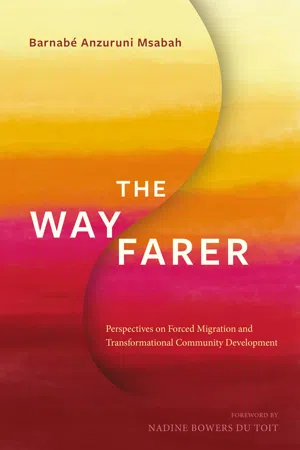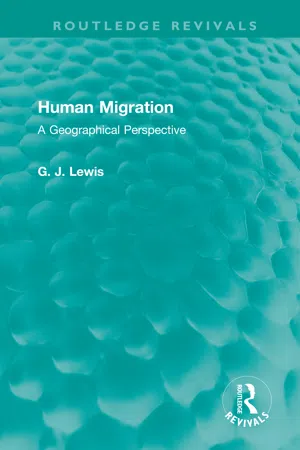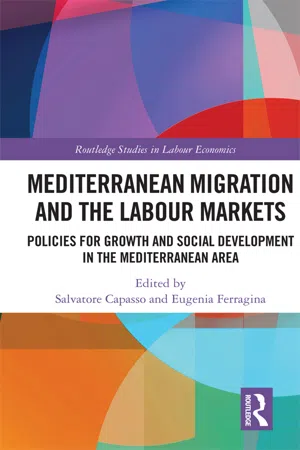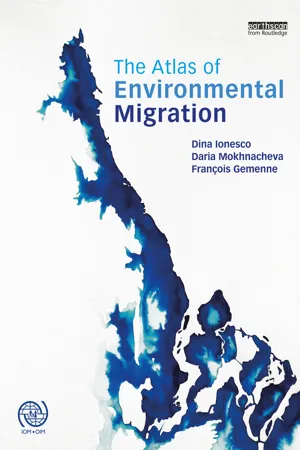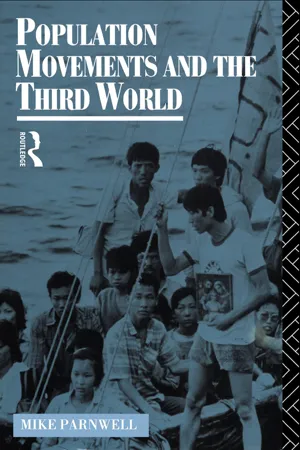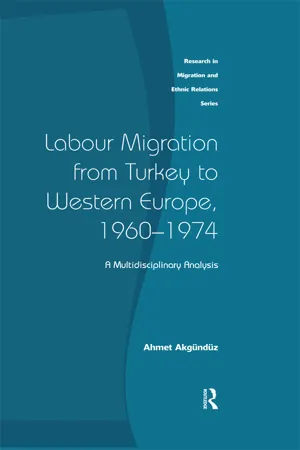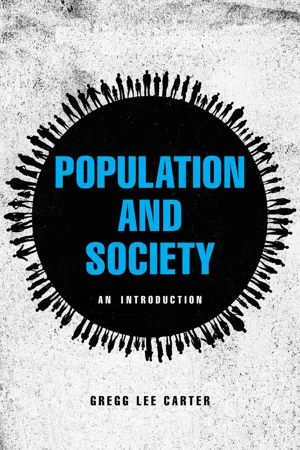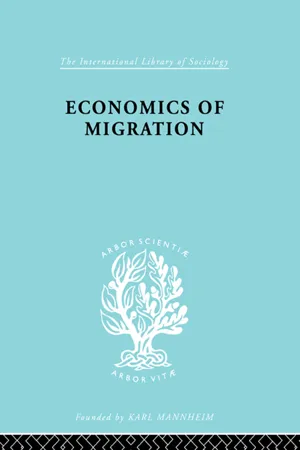Geography
Push Factors of Migration
Push factors of migration are the reasons that compel people to leave their home country and seek opportunities elsewhere. These factors can include political instability, economic hardship, lack of employment opportunities, natural disasters, and environmental degradation. Push factors are often the driving force behind migration and contribute to the movement of people across borders.
Written by Perlego with AI-assistance
Related key terms
10 Key excerpts on "Push Factors of Migration"
- eBook - ePub
The Wayfarer
Perspectives on Forced Migration and Transformational Community Development
- Barnabé Anzuruni Msabah(Author)
- 2021(Publication Date)
- HippoBooks(Publisher)
It is difficult if not impossible to draft an exhaustive and precise list of the causes of forced migration. This is why, apart from the sociopolitical and economic dynamics, it is safer to classify the rest of the dynamics in the “other” category. Many of these factors are either pull factors or push factors. Push factors are those that drive people away from their home country, while pull factors are those that attract them toward another country. Push factors include but are not limited to natural disasters, demographic changes, climate change, environmental pollution, fear of persecution, the various forms of “unfreedom,” and poverty and unemployment. Pull factors include but are not limited to the various forms of freedom, jobs or money-making opportunities, better living conditions, and strong democracy, as well as peace and security. So push and pull factors are what drive people to move away from a location and to move to a new location. Push and pull factors work together when people migrate, pushing them away from one country and dragging them to a new country. These factors create either new avenues for holistic transformation or barriers to social progress if they threaten people’s emotional stability and well-being. As a result of these factors, people change their original abode in the quest for that which they need most or which they lack in their home country.Climate change and other environmental challenges
In the Nyarugusu refugee camp, life was hard. Those of us who arrived there in 1996 when it had just opened for human habitation used the available resources for our survival. We used to cut trees to construct our tented houses and to use as firewood for cooking. Indeed, we were causing environmental degradation by cutting down trees with reckless abandon, but using firewood for cooking was a fundamental need for all the refugees since the camp was located in the jungle. It should also be noted that cutting trees is a very common practice on the African continent, despite the impact it causes on the environment, because sun-dried pieces of trees are used for firewood and for making charcoal. In addition, some houses are built using branches of trees. So without cutting trees down, our life equation would have been even more complex in this camp environment. Therefore it could be said that from an ecological point of view, our cutting of trees in Nyarugusu caused environmental deterioration, but from the point of view of our living experiences as refugees in a camp of concentration, it was a survival strategy. This contrast of perspectives is important because it shows that in Africa, climate change must be addressed within the context of poverty and deprivation so as to give the matter contextual relevance in the region.[34] - eBook - ePub
Human Migration
A Geographical Perspective
- Gareth J. Lewis(Author)
- 2021(Publication Date)
- Routledge(Publisher)
As long ago as 1938 Herberle (1938) argued that migration is caused by a series of forces which encourage an individual to leave one place (push) and attract him to another (pull). In other words, if an individual’s needs cannot be satisfied at his present location, then a move elsewhere may be considered. On the other hand, despite being satisfied with his present situation, information about greater opportunities elsewhere may persuade the individual to move. For each migration, however, several push and pull forces may be operating and interacting, so that the move cannot be attributed wholly to either force. However, by examining large migration flows, the common stimulants to movement may be established. Bogue has succinctly summarized these ‘push-pull’ forces as follows:Push factors
(1) Decline in a national resource or in the prices paid for it; decreased demand for a particular product or the services of a particular industry; exhaustion of mines, timber or agricultural resources.(2) Loss of employment resulting from being discharged for incompetence, for a decline in need for a particular activity, or from mechanization or automation of tasks previously performed by more labour-intensive procedures.(3) Oppressive or repressive discriminatory treatment because of political, religious or ethnic origins or membership. (4) Alienation from a community because one no longer subscribes to prevailing beliefs, actions or mode of behaviour — either within one’s family or within the community. (5) Retreat from a community because it offers few or no opportunities for personal development employment or marriage. (6) Retreat from a community because of catastrophe — floods, fire, drought, earthquake or epidemic.Pull factors
(1) Superior opportunities for employment in one’s occupation or opportunities to enter a preferred occupation. (2) Opportunities to earn a larger income. (3) Opportunities to obtain desired specialized education or training such as a college education. (4) Preferable environment and living conditions — climate, housing, schools, other community facilities. (5) Dependency — movement of other persons to whom one is related or betrothed, such as the movement of dependents with a bread-winner or migration of a bride to join her husband.(6) line of new or different activities, environment or people, such as the cultural, intellectual or recreational activities of a large metropolis for rural and small-town residence (Bogue, 1969, 753-4). - eBook - ePub
Mediterranean Migration and the Labour Markets
Policies for Growth and Social Development in the Mediterranean Area
- Salvatore Capasso, Eugenia Ferragina(Authors)
- 2019(Publication Date)
- Routledge(Publisher)
Given the multi-causal nature of migration, often triggered by a combination of push and pull socio-economic and political factors, it is difficult to extrapolate a direct causal link and isolate any one driver as necessary or sufficient. A conceptual model helpful to understand the role of the environment as a migration driver was developed for the 2011 UK Foresight Report (Figure 8.1). This model, highlighting the different interactions with other economic, social, political and demographic variables, explains how and with what effects environmental and climate changes can drive migration. Empirical research corroborates the hypothesis that migrations related to both sudden and slow-onset events are likely to be predominantly internal, with movements being rural-rural and rural-urban. Even when international migration occurs, it develops especially over small distances, towards the nearest borders (Lazko and Aghazarm 2010). In some situations, such as sudden natural disasters, people may have little choice but to move. In other situations, where environmental change is gradual, movement is more likely to be voluntary and linked to other push factors. Moreover, it may also happen that people affected by environmental stress do not migrate either by choice or by the lack of resources needed to move. In many cases, it is precisely the severity of the environmental impact that further erodes the financial, social and even physical assets required for moving away, leading to what has been called ‘trapped populations’ (Geddes 2015). Figure 8.1 The complex drivers of migration Source: Foresight 2011 Furthermore, the number of migrants forced to move by the impacts of environmental changes will largely depend on the adaptation policies that are implemented in order to cope with such impacts - eBook - ePub
- Dina Ionesco, Daria Mokhnacheva, François Gemenne(Authors)
- 2016(Publication Date)
- Routledge(Publisher)
Environmental change and events can be associated with different mobility outcomes, forced or voluntary, short term or long term, depending on the specific context and characteristics of the environment, country, localityor household. It is important to remember that the impacts of environment on mobility are seldom direct, except when sudden disasters physically displace people. Instead, migration is motivated by a variety of factors, among which environmental concerns are usually secondary. Environmental stress adds to other existing considerations that motivate migration, such as economic concerns (a search for higher incomes and more stable jobs), political motives (conflict, violation of human rights, discrimination), demographic pressures (growing population, pressure on food production systems), or social and personal motives (marriage, reuniting with family). Disasters or gradual degradation of vital resources can also act as an aggravating factor undermining livelihoods: mass destruction following disasters, or the gradual loss of ecosystem services (such as the availability of drinking water, agricultural potential, natural protection from hazards) may for example lead to economic, political or personal insecurity, thus indirectly contributing to migration or displacement of populations, In fact, what sometimes seems to be economically or politically driven migration or displacement can at times turn out to be related to underlying environmental causes, which can be hard to identify at first sight. Individuals may be moving in the hope of finding better living conditions and economic opportunities elsewhere as their livelihoods become increasingly insecure due to recurrent environmental shocks, such as drought or floods; or in anticipation of future irreversible changes, such as sea-level rise.In the context of disasters, the risk of displacement is not straightforward either, and is based on several elements: the existence of a hazard; the physical exposure of the population, of assets and of livelihoods to the hazard; pre-existing vulnerability of people, which is a key factor in the outcome of a hazard and in the way in which it will impact the population; and finally, the preparedness and response capacity of the population. Exposure can be influenced by demographic change: as the population grows in hazard-prone areas, more people and more assets become exposed to hazards. Urban population growth is infact one of the greatest drivers of disaster risk. In addition, people's vulnerability is shaped by economic, social, political and physical factors, such as unequal wealth distribution, social inequality or discrimination, age, health or disabilities. It can also be influenced by environmental factors: recurrent hazards or gradual environmental degradation can undermine people's livelihoods and increase their vulnerability in the long term. It is often those who are already extremely vulnerable and less able to prepare for and respond to a disaster, who suffer the greatest impact and highest risk of forced displacement. - eBook - ePub
Governing Climate Induced Migration and Displacement
IGO Expansion and Global Policy Implications
- Andrea C. Simonelli, Kenneth A. Loparo(Authors)
- 2016(Publication Date)
- Palgrave Macmillan(Publisher)
Capitalist development causes both pull- and push-based migration. Globalization essentially means flows across borders of capital, commodities, ideas, or people. National governments remain suspicious of the latter two (Castles, 2007). This body of work, however, does not consider the larger sphere of situational influences that can affect a potential migrant. A subsistence farmer who has a poor growing season is not necessarily looking to move into a new career as much as to supplement a current short-term difficulty. The same can be said for the same farmer whose business has dried up due to trade agreements. NAFTA has been a disaster for small farmers in Mexico, increasing rural poverty. An estimated two million Mexican corn farmers have been forced out of business by cheaper, subsidized US imports (Belton and Morales, 2009). These examples and their implications begin to question the extent to which migration is purely voluntary in the sense of economic maximization or is forced based on prevailing outside influences. This discrepancy will be discussed further in the next chapter. 1 Forced migration as a field of study Forced migration studies is a subfield of migration studies. It is concerned with the types of “push” factors which drive migrants to leave their homes. This also includes studies on displacement types, such as disaster induced displacement, development induced displacement, environmental displacement, and all those labeled refugees. 2 The main debate within this subfield is whether refugee studies should be part of forced migration studies or be a separate field of study. Hathaway (2007) argues that marrying refugee studies with forced migration studies will take away from the special circumstances of refugees and encourage work on the phenomenon itself instead of on refugee rights - eBook - ePub
- Mike Parnwell(Author)
- 2006(Publication Date)
- Routledge(Publisher)
In spite of its high level of generalization, Lee’s model is useful in pointing us in the direction of the factors which should be examined if we are to understand why people move. Thus, we need to be mindful of the circumstances which prevail in the areas from which migrants are moving, and in the areas upon which their movement is focused. We also need to consider the migrant’s propensity to move, and the factors which both facilitate and hinder the movement from one place to another. The following discussion seeks to accomplish this with reference to factors associated with the development process, both in source and destination areas, which influence the scale and pattern of migration in the Third World, and particularly that which takes place between the countryside and the city. We start with a brief assessment of some of the factors which may serve to ‘push’ migrants from their rural homes.Rural ‘push’ factorsIt would not be difficult to draw up a systematic list of the various forces and conditions in rural areas which underpin people’s decisions to move to new locations. Factors such as population growth, land shortages, low levels of agricultural productivity and income, and a weak non-agricultural sector have all exerted a powerful influence on the incidence of rural emigration. In reality, however, it is very difficult to isolate the influence of one or the other factor: these and other influences, including those which emanate from the city, are interrelated and exert a simultaneous influence on the migration decisions of individuals and communities.Plates 4.1The drudgery of rural life. Many migrants in the Third World are only too keen to escape the hardships and uncertainties which are often associated with life in the countryside.One of the most commonly used explanations for out-migration from rural areas is the high rate of rural population growth in many Third World regions. Whilst rural populations are in general growing at a slower rate than in urban areas because levels of urbanization are still quite low, particularly in Africa and Asia, the numerical increase of population in rural areas is often substantial. The simultaneous occurrence of rural population growth and rural out-migration leads to the convenient conclusion that one is causing the other. This assumption underpinned a number of analyses of migration in the 1950s and 1960s where the movement of population was thought to reflect a surplus of labour in rural areas which was largely a consequence of demographic pressures. Whilst there may be a close link between high population densities and the incidence of migration, as is the case with migration to the Sierra Leonean capital Freetown, population growth is not in itself the main cause of emigration from rural areas. Its effects have to be seen in conjunction with the failure of other processes to cater adequately for the needs of the growing rural populace. - eBook - ePub
Labour Migration from Turkey to Western Europe, 1960-1974
A Multidisciplinary Analysis
- Ahmet Akgunduz(Author)
- 2017(Publication Date)
- Routledge(Publisher)
In both cases the industrial revolution has destroyed traditional systems of production, but has at the same time brought about a population explosion by drastically reducing the death rate. The result is a surplus of people who cannot find employment in their own countries, and who are faced with a choice between poverty and near starvation at home, or emigration to Western Europe where industry urgently needs labour. 29 Similarly, Abadan-Unat 30 argues that ‘the major push factors in the sending countries are: unemployment, poverty and economic underdevelopment’. According to Salt, 31 the push factors are ‘higher population growth rates’ and ‘widespread unemployment and slow economic growth’. Salt and Clout 32 put forth that ‘all the time an underlying factor has been natural increase of population’ and ‘the disparity between population and economic growth’. The authors mention Turkey as an example for their view. Kağıtçıbaşı, 33 by making reference to Castles and Kosack, lists ‘the major push factors’ as ‘unemployment and underemployment, poverty and slow industrialisation’. Since the arguments of ‘unemployment’ and ‘fast population growth’ will be dealt with in ensuing parts of relevance, here I pay attention only to the argument of ‘slow economic and industrial growth’ (and thus the disparity between economic and population growth and poverty), and whether it tallies with the Turkish case, thus helping to explain the causes of migration pressure. Easily accessible data on the economic performance of Turkey, however, paints rather the opposite picture to that described above. According to the OECD, 34 for example, during the migration years, with the exception of 1960 and 1961, annual real growth in gross domestic product (GDP) of Turkey was quite high, notwithstanding noticeable fluctuations in annual performance - eBook - ePub
Global Climate Change and Human Health
From Science to Practice
- Jay Lemery, Kim Knowlton, Cecilia Sorensen, Jay Lemery, Kim Knowlton, Cecilia Sorensen(Authors)
- 2021(Publication Date)
- Jossey-Bass(Publisher)
In this chapter, we discuss four case studies that examine different drivers of climate change that result in forced migration. The Lake Chad Basin crisis demonstrates the importance of water security by looking at the role of water in poverty, conflict, and regional stability. We discuss land availability in the small island nation of the Marshall Islands and its vulnerability to a rising sea and extreme weather events. Extreme weather events are again discussed in the case study of Bangladesh to understand recurrent natural disasters as a driver of migration. The final case study links climate change with infectious diseases, linking climate mediated rural-urban migration with the 2019 dengue outbreak.Table 23.1 Drivers of Forced MigrationDrivers of Migration Examples Political Conflict and insecurity Weak state institutions Persecution and marginalization Economic Lack of employment Cost of living Demographic Population size and density Disease prevalence (e.g., outbreaks) Environmental Land and water security Land productivity Habitability Social Obligations to family Existing social network Pursuit of education Source: Adapted from Government Office for Science (2011).The Decision to Migrate
Individuals experiencing political, economic, and environmental hardships face a difficult choice: stay in their homes and attempt to adapt to the changing environment or migrate to a new community or country. Both lead down roads with uncertain futures. The relative weight between these options depends on the individual's specific situation and broader socioeconomic context. Ongoing armed conflict may prevent migration, for example, if any form of travel could be more dangerous than remaining in place. Extreme poverty creates another barrier, since travel is risky and requires significant resources (Black et al. 2011 ).Figure 23.3 - eBook - ePub
Population and Society
An Introduction
- Gregg Lee Carter(Author)
- 2016(Publication Date)
- Polity(Publisher)
In some cases, governments have forced the population transfer of a particular ethnic or religious group from one region to another; and in other cases, the chaos and dread associated with civil wars, insurrections, revolutions, and persecutions have created a situation of impelled migration, in which individuals, families, and groups flee their homes in search of safe havens – often involving the crossing of national borders. The following briefly developed examples, one historical and one contemporary, illustrate the importance of this macro factor in explaining geographic mobility. Note that such examples could readily be drawn exclusively from almost any and all of the individual histories of the world's current 195 countries. The Africa to the Americas slave trade - eBook - ePub
- Julius Issac(Author)
- 2013(Publication Date)
- Routledge(Publisher)
11 A similar reaction to obviously temporary changes of prosperity can be found in practically all countries of immigration, so that our approach has some justification. This tendency of migration to adapt itself to temporary changes of prosperity has several causes. We shall deal later with the costs of migration, but in this context it is necessary to mention that migration is to a large extent financed by assistance from friends or relatives in the new country. This help can be given more liberally in times of prosperity. Expectations—apart from periods of political or social unrest—are based on present conditions, and it is usually presumed that the present trend will not change. On the other hand a great deal of migration is caused by an attempt to escape immediate destitution, so that long-term expectations are only of secondary importance.A distinction has been made between “push” and “pull” migration. It may safely be assumed that the migrant who is driven from his country by adverse conditions of life or by other circumstances is more concerned with his present lot than with more or less vague expectations for the future. The migrant who has lived under tolerable conditions but who expects to become better off by migration will attach more importance to future prospects. He will often be prepared for a considerable lowering of his standards of living during the first years after his immigration, if he is convinced that this loss will be atoned for by later gains. The settler in an undeveloped region is usually well aware that conditions for himself and his family will be very hard and that he will live much less comfortably than before his emigration, until he has become settled and paid off his debts. In the same way other categories of immigrants are prepared to sacrifice present satisfactions. They will not be discouraged by the fact that they will have to become acquainted with the language, customs, and habits of the new country before they can expect to receive their fair share of its benefits. Such reflections will affect their decisions only in so far as they will take account in their calculations of the losses which may occur during the period of transition. They will leave their country only if the margin between their present standard and the corresponding standard in the new country is wide enough to allow for their handicap as newcomers. This includes provision for unemployment, likely to occur during the first stage after their arrival. If the labour market is ruled by free competition, especially in an expanding economy—as in the chief countries of immigration up to the last war—the individual immigrant will soon find some kind of employment if he sells his services below their market price. He is more mobile than his native competitors, who are already settled, and his inferior standard of living enables him to work at a wage rate low enough to overcome the bias of employers against foreign labour. Even if below the general subsistence level, this rate may be still attractive for him. This margin between the general wage level and the level of wages for immigrants’ jobs has been very considerable during the pre-restriction period of U.S.A. immigration. In 1905–07—a period of extensive immigration comprising various phases of the business cycle—wages of a single man immigrant in comparison with the American worker’s wages were as follows:12
Index pages curate the most relevant extracts from our library of academic textbooks. They’ve been created using an in-house natural language model (NLM), each adding context and meaning to key research topics.
